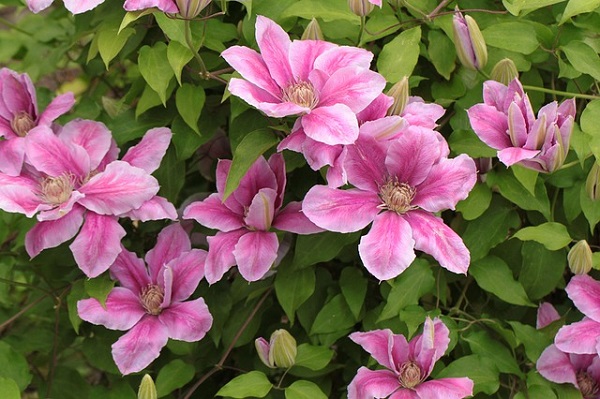With proper clematis care, you can have beautiful, vigorous climbing vines with exquisite flowers. There are several hybrids that produce large colorful flowers. When purchasing clematis, choose healthy vines that are at least one foot tall with multiple vigorous stems. To enjoy continuous blooms from late spring through autumn, plant a combination of early, mid-season, and late bloomers.
Location
The clematis does not like being moved around once settled. Choose your site with care to avoid problems. If you do not have well-drained soil, add some sand or pebbles. Consider the blooming time of the clematis when choosing your location. Most clematis require about six hours of sun daily, but all varieties want cool roots. Use up to three inches of organic material to mulch over the roots, or find a place where the roots are protected by some shrubs. For sites with heavy clay soil, your hole should be at least two feet deep and two feet wide. If it is sandy, or has lighter soil, you can make do with about a foot and a half.
Planting the Clematis
- Prepare a hole with depth and width of about one foot and one half. Set aside the removed soil.
- Fill the bottom of the hole with about two pounds of composted material (approximately two shovels full). If you are using manure, it has to be well-rotted. Never use raw manure as it will scorch plants.
- Mix the set-aside soil with a very good amount of composted material or well-rotted manure. Pack lightly some of the mixture on the composting material in the bottom of the hole.
- When you are ready to plant, moisten well the roots by soaking the clematis pot in water for about ten minutes. Avoid over-soaking.
- Plant the clematis so that its root ball is about two inches below the soil. Pack lightly with your hand all the remaining soil mixture in the hole. It may be higher than ground level since you added compost material to the soil taken from the hole. The hump will settle down quickly enough.
- Tie the stems to the trellis with care, so that you can train the new growth where you want it. The clematis needs good support for proper growth.
- Water the clematis deeply immediately after planting.
- When the clematis buds are grown about two inches, you can start with fertilization. If your soil is high in organic matter, feed the clematis every four weeks. If your soil is poor, fertilize every two weeks. If the flowers are in full bloom, do not feed till after the main flowering season is over.
- Choose fertilizers including sequestered iron, but avoid those with too much nitrogen








